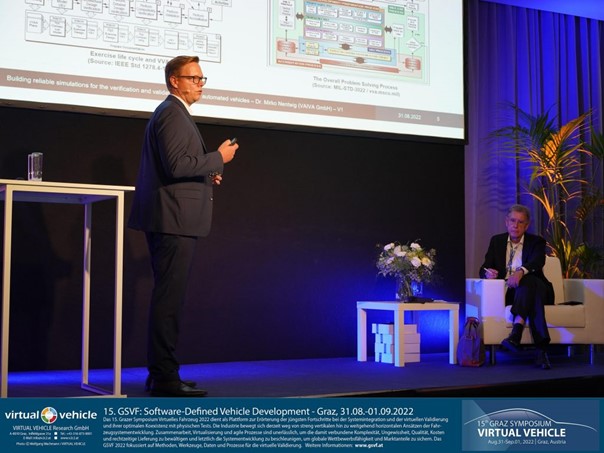Reliable simulations as a success factor in the development of highly automated vehicles

One of the most important success factors in the development of highly automated vehicles is the verification and validation of simulations. At this year’s Graz Symposium Virtual Vehicle (GSVF), VAIVA shared detailed insights from our wealth of experience and showed efficient ways to achieve high quality results in the field of simulation development..
At this year’s Graz Virtual Vehicle Symposium (GSVF), VAIVA presented a paper on “Building reliable simulations for the verification and validation of highly automated vehicles”. The application of simulations and the necessary framework conditions are the core contents of the conference. This year’s focus was on “Software-Defined Vehicle Development” with a focus on highly automated driving and its framework.
One of the most important steps for the development and production of highly automated vehicles are verified and validated simulations. Solutions on how to best create and use these simulations are currently the subject of various research and standardization initiatives. Mirko, responsible for Virtual Development, spoke about VAIVA’s experience in this area..
The currently favored process models for the creation of simulations and modeling all follow more or less the classical approach of a V-model and are therefore compatible with approaches from software development. Many software companies in the automotive sector have already implemented processes such as ASPICE2. This can be used as a starting point for the development itself, as well as for the verification and validation (V&V) of the simulations. Thus, a known framework exists for the creation of specifications, designs, implementations and V&V. If this is applied to all artifacts, a high level of transparency, and thus trust, is achievable, all the way to the final code..
Another important aspect is the support of verification and validation, through automation – because through more frequent testing, better transparency about the maturity of the simulation can be achieved. The implementation here should be done with known tools of software development. After the realization of the infrastructure, it can be integrated into a Continuous Integration pipeline. In addition to the automatic evaluation of the quality, integration steps of the simulation can be realized with it.. In addition to the numerous presentations, there was also the opportunity to exchange information with other experts about the state of the art and current developments, e.g. the current initiatives to create a “SPICE” process for modeling & simulation. Intensive discussions also arose about the pros and cons of standards for simulations in general and about the development of sensor models.
by Mirko